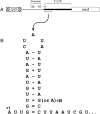Helicobacter pylori vacA transcription is genetically-determined and stratifies the level of human gastric inflammation and atrophy
- PMID: 27189958
- PMCID: PMC5136723
- DOI: 10.1136/jclinpath-2016-203641
Helicobacter pylori vacA transcription is genetically-determined and stratifies the level of human gastric inflammation and atrophy
Abstract
Aims: Helicobacter pylori infection is the major cause of peptic ulceration and gastric cancer, and an important virulence determinant is its vacuolating cytotoxin vacA. Previously, we have described allelic variation in vacA which determines toxin activity and disease risk. Here we aimed to quantify vacA mRNA expression in the human stomach, define its genetic determinants and assess how well it predicts gastric pathology.
Methods: Gastric biopsies were donated by 39 patients with H. pylori infection attending for endoscopy at Queen's Medical Centre, Nottingham, UK. Total RNA was extracted, and vacA mRNA quantified by reverse transcriptase quantitative PCR. Separate biopsies were histologically scored for inflammation and atrophy using the updated Sydney system. H. pylori strains were isolated from further biopsies, and the nucleotide sequence upstream of vacA determined.
Results: vacA mRNA levels in human stomachs varied by two orders of magnitude independently of vacA allelic type. Among vacA i1-type (toxic) strains, increased vacA expression was strongly associated with higher grade gastric inflammation (p<0.02), neutrophil infiltration (p<0.005) and the presence of atrophy (p<0.01). A polymorphism at nucleotide +28 near the base of a potential stem-loop structure within the 5' untranslated region was significantly associated with vacA transcript level and inflammation.
Conclusions: Increased gastric vacA expression during H. pylori infection is associated with inflammation and premalignant pathology. The +28 nucleotide within the vacA 5' stem-loop stratifies disease risk among toxic vacA i1-type strains.
Keywords: GASTRIC PATHOLOGY; HELICOBACTER PYLORI; INFLAMMATION; MICROBIAL PATHOGENIC; TOXIN.
Published by the BMJ Publishing Group Limited. For permission to use (where not already granted under a licence) please go to http://www.bmj.com/company/products-services/rights-and-licensing/
Conflict of interest statement
Conflicts of Interest: None declared.
Figures




References
Grants and funding
LinkOut - more resources
Full Text Sources
Other Literature Sources
